The cryptocurrency market is unpredictable, but the key is to think long-term! From 100,000 to millions: avoid small profits and risky ventures, and follow these 3 steps to ensure stability for ten years!
As someone born after '85, I've long passed the age of 'charging into the world.' After nearly ten years in the cryptocurrency space, I can call myself an 'old hand.' Half of it comes from experience, and the other half from age. Nowadays, there are many young people in the crypto space, born in '95 and '00, who are bold and daring. However, when it comes to the storms we've faced, those of us from '85 have a bit of 'experience' that gives us confidence—after all, we experienced the ICO craziness of 2017, endured the crash of March 2020, and witnessed Bitcoin rise from a few thousand to sixty thousand dollars.
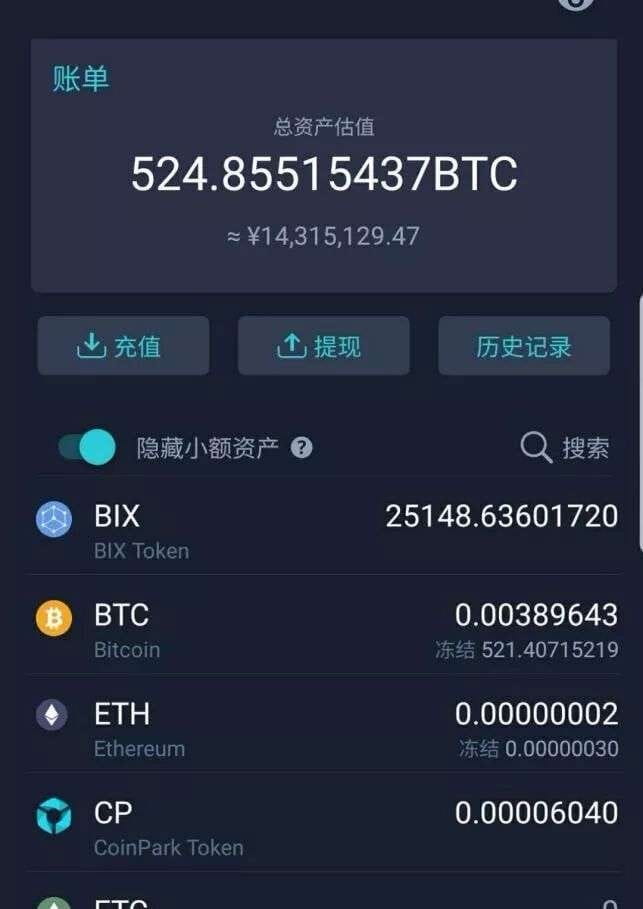
Experts reach a lonely peak, and countless hardships are hard to sing about.
A survivor in the trading arena has summarized several trading rules that precisely meet the above criteria. I list them here in hopes that investors can increase their profits and stay away from pain.
Whether you are a novice or an expert, you often overlook the psychological factors that contribute to successful trading. Trading is undoubtedly one of the most stressful jobs in the world, akin to fire-eating performances or bomb disposal.
Trading performance can sometimes feel like a roller coaster, rising and falling, always mixed with joy and sorrow. A moment of inattention can shatter investors' psychology and trample their souls. As long as you enter the market, such experiences are inevitable, but investors can learn how to deal with these situations and even profit from them.
Never go against the market; in a market trend, you can only move with the trend, never against it.
Carefully analyze the market and correctly judge the main trend. Buy or sell at the clear establishment of the main trend, and decisively close positions at the end of this main trend.
1) Correctly study the main trend of the market and prepare to act based on that. This is a crucial step in investing; you must concentrate fully and continuously track and study the market, doing more and speaking less.
2) Establish new positions in accordance with the main trend of the market. You need to closely monitor the market, dedicating several weeks or longer to gradually build new positions.
3) As the main trend of the market continues, gradually reduce the position size. This is especially important; many traders fail because they gradually increase their trading volume while the main trend continues, which inevitably leads to losses when the main trend reverses. This is because most of the investors' funds are invested in areas near the top (or bottom).
4) At the end of the main trend, decisively close all positions.
The only effective strategy is to intervene when the main trend is forming and exit when it reverses. If the main trend reverses when you buy, do not go against the main trend. Manage your positions well, exit the market, and rethink new trading strategies. Only by grasping the pulse of the market and acting in accordance with the main trend can you achieve profits.
So how can we excel at trading cryptocurrencies? Once a person enters the financial market, it's hard to turn back. If you're currently losing and still confused, but plan to treat cryptocurrency trading as a second career, you must understand the 'buying at the bottom strategy.' Comprehending it can save you from many pitfalls; these insights are based on personal experiences and feelings. I recommend saving them and reflecting on them repeatedly!
How to buy at the bottom?
My method consists of 3 steps.
1. My standard for buying at the bottom.
5 minutes to teach you how I buy at the bottom!
Since we're talking about buying at the bottom, it definitely means 'turning from short to long'; what we need to do is reverse a certain downtrend. Therefore, it’s crucial to learn whether the recent downtrend has completed. If it hasn't, and you try to buy once and find you bought in mid-descent, you may hesitate to buy when it finally completes, resulting in missing the opportunity.
So how do we determine if a downtrend has completed? Three steps:
Step 1: Find concentrated areas.
Step 2: Compare sizes.
Step 3: Look for divergence.
2. How to buy at the bottom?
Step 1: Find concentrated areas.
Let's first look at step 1: find concentrated areas. Finding concentrated areas refers to concentrated trading zones, essentially the oscillation trading ranges we've learned in essential price behavior courses and the midpoints from the theory of price action.
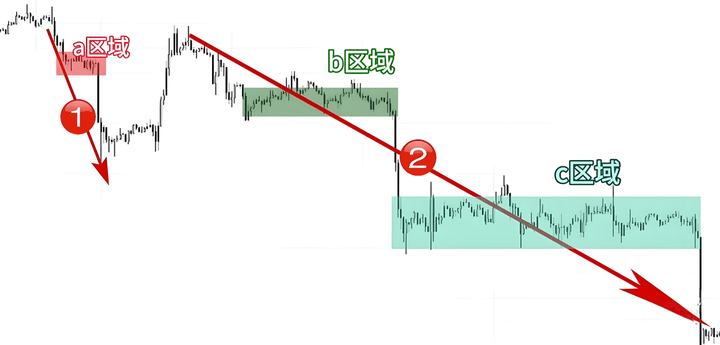
(Figure 1)
For example, this area in region A is the concentrated trading area for downtrend 1; this area in region B is the concentrated trading area for downtrend 2, and similarly, this area in region C is also the concentrated trading area for downtrend 2; (Figure 1)
In step 1, finding the concentrated trading areas means identifying all the concentrated areas in the observed downtrend to complete step 1.
If you don't know how to define which downtrend to observe, whether it's this segment or that segment, you can use the concept of the associative law from the theory of price action (Panda's Lecture on Price Action Theory, Lecture 13: Associative Law and Polysemy) to learn.
Step 2: Compare sizes.
After completing step 1, step 2 is to compare sizes.
Whose size is bigger? Compare the sizes of all the concentrated trading areas you found in step 1, and identify the one you believe has the 'largest area, most candlesticks, and longest stagnation time' during this downtrend, then label it.
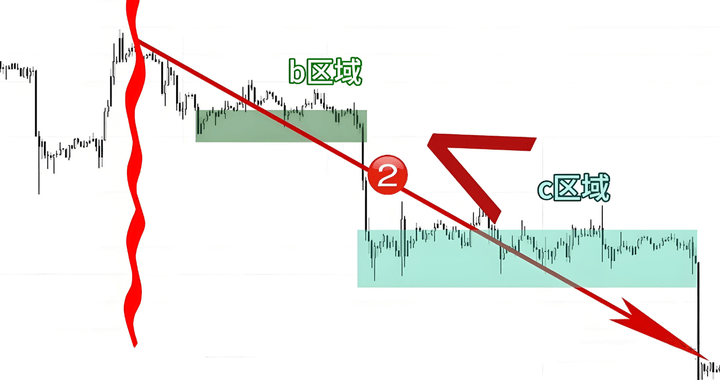
(Figure 2)
For example, using the previous case, if we apply the associative law to separate here and focus only on downtrend 2, we can see the two concentrated trading areas B and C within this downtrend. (Figure 2)
We can clearly see that the C area is larger than the B area, with more candlesticks and a longer stagnation time. Therefore, we have already completed step 2: identifying the largest concentrated trading area and attempting to label it.
Step 3: Look for divergence.
Next is the final step: look for divergence.
What is divergence? Simply put, it means one segment is weaker than another. Zhang San participates in an off-road marathon, and normally, the longer the rest time, the longer the distance he should run afterward. However, the reality is: the longer Zhang San rests, the shorter the distance he can run afterward. Previously, resting for 1 minute allowed him to run another 10 kilometers, but now resting for 5 minutes means he can only run 8 kilometers at most. This is when we say Zhang San's strength is diverging.
This is a sign of exhaustion; in simple terms, it means it's almost over! It has already reached a critical point.
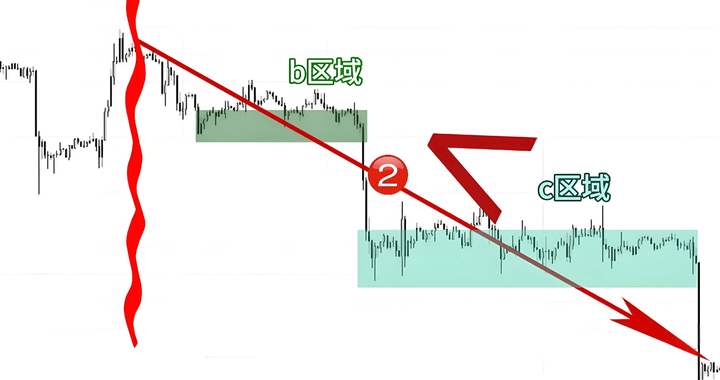
(Figure 3)
After understanding what divergence means and knowing how to find the area with the largest concentration of trading, I now ask you: regarding the downtrend number 2, if we take the largest concentrated area as a dividing point, comparing the small segment a before entering the concentrated area with segment b after leaving it, has there been any divergence? Has there been a weakening trend?
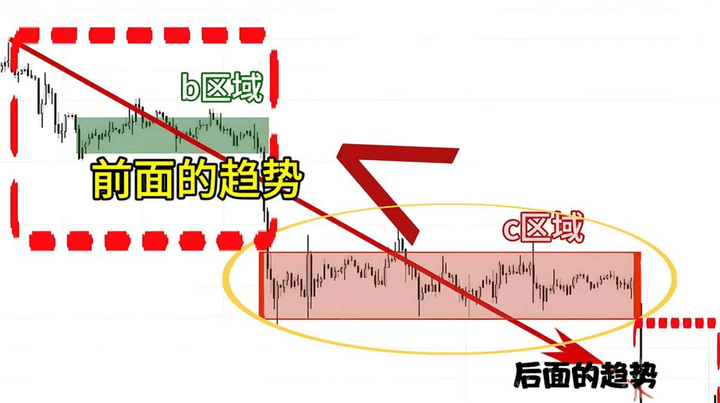
(Figure 4)
Logically, if it rests longer here, it should be able to run farther forward, right? So why is it that now, while running, it can't even reach the distance of segment a? (Figure 4)
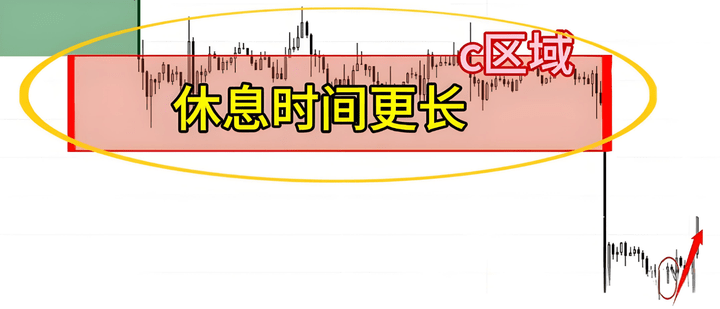
(Figure 5)
You might ask, how do you know it's not working?
Step 1: It has formed a bottom K-line pattern.
Step 2: It has already moved up once, ending this downward segment. (Figure 5)
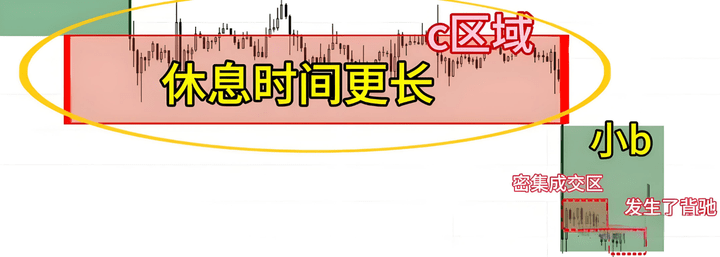
(Figure 6)
Step 3: This small segment b also has a self-similar structure and its own concentrated trading area, which is here, and it also shows divergence. (Figure 6)
If you don't understand any of this, don't worry; I'm confident that after completing my essential course (bare K-line section), you will understand everything.
3. Summarize and conclude.
Alright, let’s summarize how I teach you to buy at the bottom in 5 minutes, using a three-step approach.
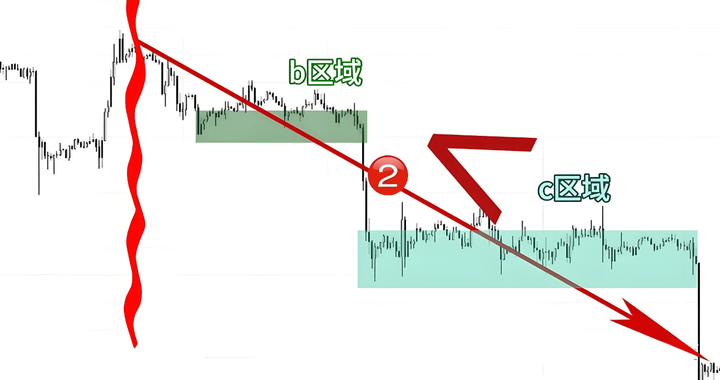
(Figure 7)
Step 1: Find concentrated areas. I have already found B and C. (Figure 7)
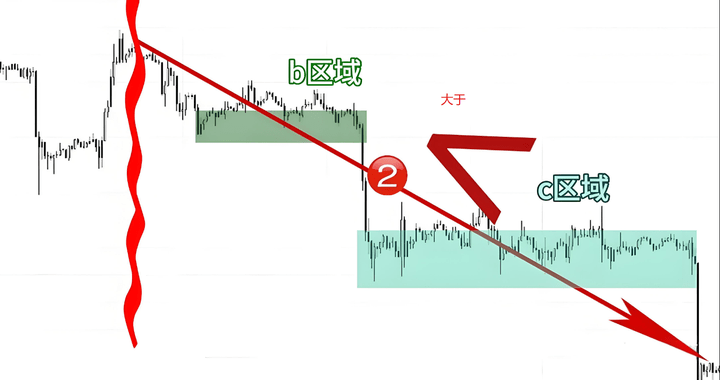
(Figure 8)
Step 2: Compare sizes. Clearly, area C is larger than area B, and I’ve found it. (Figure 8)
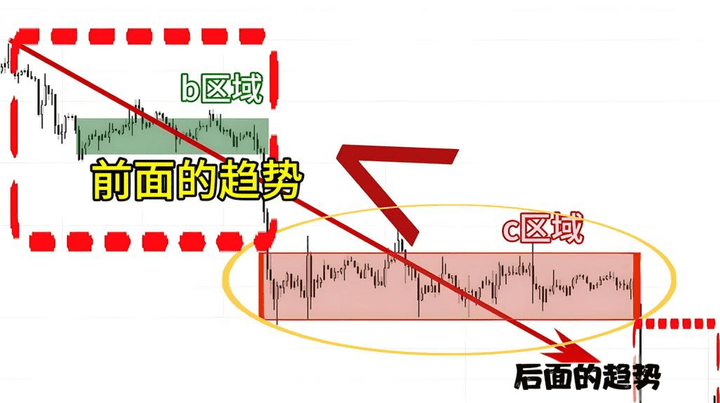
(Figure 9)
Step 3: Look for divergence. We only need to observe which area has the largest area and compare the trends before and after it. We know that divergence has already occurred. (Figure 9)
Therefore, we can try to buy at the bottom and go long, but we must control our positions well. After all, this is an entry opportunity on the left side; we absolutely must not go all in! My principle is to not exceed 50%!
Don't rush! It's not over yet. You say, 'Coach, I've learned it, but now I still have two questions.'
1: Now that I know how to buy at the bottom, how do I sell at the top? Buying is for apprentices; selling is for masters. You've taught me how to buy at the bottom, so how can I sell at the top?
②: If I find many concentrated trading areas of equal size, how should I compare divergence?
If you are also a tech enthusiast, take a look at the following image:

Finally, let me mention this: 9 lazy strategies for trading cryptocurrencies to profit while avoiding scams.
1. Mainstream coin accumulation method: The accumulation method is relatively simple but difficult to execute. First, buy a few mainstream coins in spot trading, and then hold them for a year or more without trading. Generally, the returns will be several times (it’s not advisable to buy small coins, as they might go to zero). However, beginners often see high returns or encounter price halving and plan to switch coins or exit, making it difficult for many to hold for even 3 months, let alone years.
2. Bull market chasing decline method: This strategy is suitable for buying mainstream coins in a bull market, as mainstream coins generally won't be stuck for too long. For example, if you buy Bitcoin and it rises by 30% or more, you can switch to the next declining mainstream coin, and continue this cycle. If you bought in the wrong direction and are stuck, just wait; the bull market will definitely help you break even. The prerequisite is not to buy small coins; major coins like Bitcoin and Ethereum fluctuate quickly, making this strategy easy to control.
3. Hourglass trading method: In a bull market, nearly any coin you buy will rise; funds flow like a giant hourglass, gradually seeping into every coin. There’s a clear pattern: Bitcoin rises first, then mainstream coins start to rise, followed by smaller coins. However, if Bitcoin rises, you should pick the next category that hasn't risen yet to start accumulating.
4. Pyramid buying method: Predicting a significant drop in a coin, establish 4 positions, placing orders to buy one-tenth of the position at 80% of the coin price, two-tenths at 70%, three-tenths at 60%, and four-tenths at 50%. Once a rebound begins, you can start to take profits incrementally.
5. Moving average method: Understand some basic K-line indicator parameter settings; select a daily chart. If the current price is above the MA5 and MA10, hold on. If the MA5 breaks below the MA10, sell; if the MA5 breaks above the MA10, buy and build positions.
6. Rolling warehouse accumulation method: This is only suitable for long-term mainstream coins. For example, if the current price of Bitcoin is 1658, place an order to buy at 1458. Once the order is executed, place a sell order at 1958. Use the profits to accumulate coins and take out the liquid funds to wait for the next opportunity, adjusting dynamically according to the current price. If there are three such opportunities in a month, you can accumulate quite a few coins.
7. Compound interest method: Continuously participate in multiple bets. When a new coin increases by 3-5 times, withdraw the principal and invest it into the next bet, keeping the profits for further investment, repeating the cycle.
8. Cycle wave method: Find coins like EC that are dark horses; increase your holdings as the price of the coin keeps dropping, and when it rises, sell to take profits, and continue this cycle.
9. Trend-based long-term strategy: If you have 3000 USD, divide it into three parts, buying three different types of trend coins, such as those proposed by the Federal Reserve, excluding Bitcoin and Ethereum. If a certain coin triples, withdraw the principal of 1000 USD and reinvest the profits in the next market, which can yield extraordinarily high returns with compound interest.
The above are ten years of trading insights in the cryptocurrency space. After many bumps and bruises, these are heartfelt words of wisdom that I hope are useful to everyone. Quality products come from well-prepared sources; there are outstanding individuals in the cryptocurrency world, unique and independent. With a soulful approach, mastering cryptocurrency requires skill!
No matter how diligent a fisherman is, he won't go out to sea during a storm, but will carefully protect his boat. This season will pass, and sunny days will come! Follow me, and I will teach you how to fish and how to fish effectively. The cryptocurrency market is always open; only by following the trend can you lead a life in sync with it. Save this and keep it in mind!